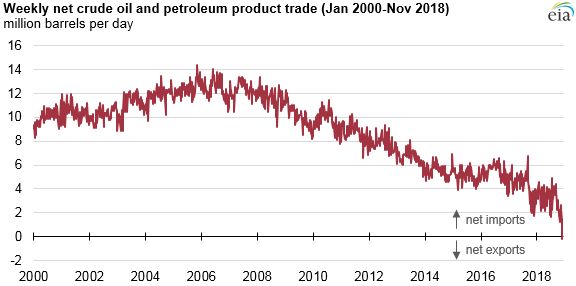Thinking about the year in energy in 2018, a couple of recent news items focus attention on the sea change for our country launched by the U.S. natural gas and oil revolution:
Net Oil and Refined Product Exporter
The U.S. became a net oil and petroleum products exporter for the first time in 75 years in November. Bloomberg:
The shift to net exports is the dramatic result of an unprecedented boom in American oil production, with thousands of wells pumping from the Permian region of Texas and New Mexico to the Bakken in North Dakota to the Marcellus in Pennsylvania. … “We are becoming the dominant energy power in the world,” said Michael Lynch, president of Strategic Energy & Economic Research.
The U.S. Energy Information Administration (EIA) provides detail, showing that for the week ending Nov. 30, the United States exported more crude oil and petroleum product than it imported – for the first time in EIA’s weekly data since 1991. That’s an estimated record 3.2 million barrels per day of crude and an estimated 5.8 million barrels per day of petroleum products, such as distillate fuel oil, gasoline and propane.
Below, EIA’s chart showing the shift from net U.S. oil/petroleum product imports toward net export status since the mid-2000s – when domestic production began surging, thanks to modern hydraulic fracturing and advanced horizontal drilling:

API’s Monthly Statistical Report describes the strength of U.S. energy:
- No. 1 in the world in crude oil production, 11.6 million barrels per day in November
- No. 1 in natural gas liquids production, 4.8 million barrels per day in November
API Chief Economist Dean Foreman writes:
The numbers … illustrate the breadth and depth of the U.S. energy revolution and translate into economic growth and increased U.S. security in the world. In the past, U.S. production data sometimes included an asterisk – leading in some scenarios but not others. The figures above pretty much eliminate the “ifs,” “ands” or “buts” associated with any discussion of U.S. energy muscularity.
The natural gas liquids (NGLs) number is quite significant – reflecting the liquid fuels such as ethane, propane and butane that accompany natural gas production. These are critically important as fuel for home heating and cooking and the feedstocks for plastics, rubbers and the manufacturing of many of the products Americans use every day. Try this one on: The U.S. is producing NGLs at such a high level, our country’s natural gas industry, by itself, is the world’s No. 4 liquids producer (oil and NGLs) behind the U.S., Russia and Saudi Arabia.
U.S. Energy: Abundant With a Capital ‘A’
As amazing as the numbers above are, there’s more natural gas and oil out there. Earlier this month the U.S. Geological Survey (USGS) released a new assessment showing an estimated mean of 46.3 billion barrels of continuous or unconventional oil in the Wolfcamp shale and overlying Bone Spring Formation in the Delaware Basin portion of Texas and New Mexico’s Permian Basin province.
That’s a lot of oil. And natural gas, too. USGS says the Wolfcamp holds 281 trillion cubic feet of natural gas and 20 billion barrels of NGLs. The new assessment is twice as large as one USGS did just two years ago. API President and CEO Mike Sommers:
The USGS announcement “reflects yet another benefit of America’s shale energy revolution. Innovative technology developed by the U.S. natural gas and oil industry has spurred our economy, strengthened our energy security and lowered costs for energy consumers. … The U.S. energy revolution has delivered massive economic, environmental and geopolitical benefits, and it is clear that the world is better off with the U.S. as the world’s leading natural gas and oil producer.”
My own analysis: mind blown. These production and discovery numbers show the United States is incredibly rich in natural gas and oil, the leading energy sources for modern societies and economies. Now, add in the natural gas and oil potential in the U.S. offshore and in the 1002 area (coastal plain) of the Arctic National Wildlife Refugeand you begin to understand America’s vast energy possibilities.
All of these riches and the technical ability to harness them mean that increasingly, the U.S. is in control of its future. Energy security means a nation that isn’t constrained by energy concerns the way it was less than two decades ago.
As Americans look ahead to 2019, let’s pause to consider the impacts of America’s new energy reality. We should be impressed and thankful for the opportunities that go with being the globe’s leading energy producer.
Just a few decades ago, the idea that the United States would be No. 1 in the world in natural gas and oil production mostly would’ve generated laughter. Today, it’s here. For it to continue, we need policies that support safe and responsible development of our domestic natural gas and oil – gift that can keep on giving.
By Mark Green
Originally posted December 28 2018
Energy Tomorrow is brought to you by the American Petroleum Institute (API), which is the only national trade association that represents all aspects of America’s oil and natural gas industry. Our more than 500 corporate members, from the largest major oil company to the smallest of independents, come from all segments of the industry. They are producers, refiners, suppliers, pipeline operators and marine transporters, as well as service and supply companies that support all segments of the industry.

